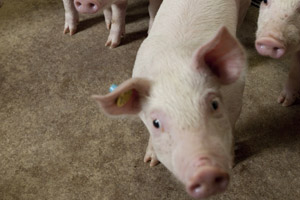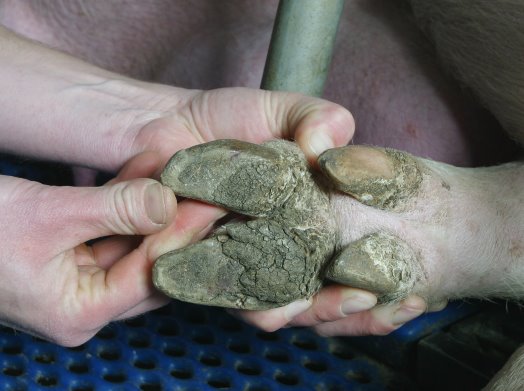Trace elements from a veterinary perspective

Copper, iron, selenium, zinc – trace minerals that are all important for a balanced nutrition to keep pigs going. It pays off looking not only at the nutritional side of them, but also at the health effects of trace minerals.
It’s becoming increasingly clear that the fields of study on pig health and pig nutrition are in fact two sides of the same coin. When pigs are fed properly, it is likely that their health is likely to be better; and when pigs feel healthy, their feed intake is also likely to be going strong.
A recent presentation by Prof Dr J. Kamphues, professor at the University of Veterinary Medicine in Hanover, Germany, exactly underlined that view when he touched on the inclusion of trace minerals in animal diets, viewed from a veterinary perspective.
As tiny elements, regular components of grains and soy trace elements are essential for day-to-day maintenance and performance of all farm animals and companion animals. There are, however, some moments in animals’ lives, when they can do with a little bit extra. These specific functions of trace elements may give an additional boost to an animal’s health – a welcome addition to a veterinarian’s toolkit.
This article aims to be comprehensive and revolves around both functions of trace minerals.
Trace minerals in nutrition
Let us first take a slightly deeper look into the regular maintenance and performance supply functions of trace minerals. Generally speaking, one could say there are five:
- to avoid specific deficiencies or clinical symptoms;
- to achieve normal blood constituent values;
- to ensure physiological enzyme activities;
- to elevate the level in ‘target tissues’
- to improve/elevate trace elements in food (under debate)
Well-known examples in pigs include the need for iron (haemoglobin) in young piglets, the use of selenium for its antioxidative capacity or the use of zinc to maintain the pigs’ skin by supporting epithelia regeneration.
Supplying the right amounts of each trace mineral is easier said than done. In raw materials, the supply of trace minerals is always variable, depending on its context, e.g. due to the presence of a different type of soil or the use of a particular fertiliser. In addition, available trace elements may also influence each other’s mode of action.
In modern pig production, trace element deficiency is therefore a problem that can occur, caused by a variety of different reasons. Iron deficiency in young piglets could be caused due to a lack of rooting opportunities in modern pig houses; a shortage of selenium can occur as in certain parts of the world, grain raw materials simply do not contain sufficient rations. And sometimes, meeting the ever-higher potential of livestock in 2015, additional supplementation simply might be necessary to avoid nutritional deficiencies.
Roughly speaking, trace elements are correctly applied when the dietary concentration is one that covers the required dose for physiological functions, indicated by enzyme activities and normal tissue levels and avoids an unnecessary environmental pollution considering aspects of safety at handling. Exact levels that can be used in pig production are usually supplied in e.g. the US’ National Research Council (NRC)’s Nutrient Requirements for Pigs, most recently updated in 2012.
It goes without saying, of course, that the absence of required amounts of trace elements in pig nutrition could be one reason for underperforming animals. Table 1 sums them up per trace mineral.
Trace elements occur in various forms and shapes. Especially with zinc, these outcomes can vary. It does make a difference whether zinc is supplied as zinc oxide, as zinc sulfate or as a chelate. To determine exactly the effect on the animal of each ingredient, in whatever form and shape, nutritionists usually use the term ‘bioavailability’. As early as 1993, a team around the German researcher Prof Dr Manfred Kirchgessner defined bioavailability as the ‘capability of metabolic use at the absence of homeostatic regulation’. Bioavailability depends on dietary properties and individual reactions.
In this respect it is perhaps good to point to trace elements bound to amino acids, also known as chelated trace minerals. Chelates make trace elements more bioavailable for organisms. In pigs, active absorption of the amino acids results in elevated trace element absorption and accumulation in body tissues (for example, Selenium in muscles).
It is good to note that quantifying bioavailability is an art in itself. Different research methods can well lead to different results. In addition, processes at dietary, digestive, absorption and metabolic levels can all play a role in determining the eventual bioavailability of a certain form of trace element. In short – establishing the bioavailability is difficult, there is always more than one answer to be found.
Sows and claw health
Turning to the application of trace minerals above minimum requirements – important for veterinary purposes – two examples jump to mind. In both cases there is a temporary situation when pigs can do with an extra supply of a certain trace mineral to be able to cope with the specific situations they are in.
Sows may benefit from being supplied additional trace minerals. Especially seeing that increasingly sows are being kept in group housing during gestation, having excellent claw quality is key, a matter that can usually be addressed by providing additional zinc, manganese and copper.
The question how the trace minerals are supplied is important as it may influence the efficacy. When offering a cocktail of trace minerals to sows in an inorganic form, effects are known to be relatively limited. When offering these as chelates, however, they are easier absorbed in an animal’s system.
When the sows are fed a source of additional organic zinc, manganese and copper, the sow’s claws benefit, as in:
- having fewer claw splits;
- having fewer alterations of the white line;
- having fewer vertical splits in the claw’s wall; and
- having fewer abnormal elongation of the tiptoe.

Sows are increasingly kept in group housing which requires high claw quality.
Piglets and diarrhoea
Probably even more well-known as an example of supplying trace minerals above requirements is when it is aimed to treat E.coli-related diseases, like e.g. diarrhoea or oedema disease. Especially when antibiotics are not meant to be supplied, zinc can serve as an alternative. This is often done, e.g. in Denmark, when zinc is supplied using high levels of zinc oxide (ZnO), often at levels of 2,500 or 3,000 mg/kg (ppm), but this is not allowed in most EU countries (due to environmental pollution).
Here as well, the form in which the trace minerals are given, does make a difference. Although ZnO is well known to alleviate scouring problems, a drawback here is that intensive usage also leads to residues in tissues as well as excretion into the environment, since concentrations are very high. A group of researchers along with Y. Wang, at Zhejiang University in Hangzhou, China, published a research in 2011 on trace mineral concentrations in organs and tissues of pigs after 35 days of treatments. They found that especially in the liver, levels of zinc are very high, when having used a ZnO dosage of 3,000 mg/kg. The researchers also measured the effects of supplying a zinc glycine chelate – in this case, the results were a lot lower. For instance, in the liver, Zn conentrations ended up to be 194 mg/kg without zinc supplementation, with ZnO supplied at 3,000 ppm this was 291 mg/kg. When supplying zinc glycine chelate at 50 ppm and 100 ppm respectively, however, these levels were 204 and 212 mg/kg.
Oversupplying
As is the case with most ingredients, also for trace minerals too much is seldom a good idea. If not for environmental reasons, some trace elements can be toxic when consumed in too high amounts. With pigs, one could think of effects of oversupply of iodine (leading to compromised meat quality) or an oversupply of selenium, which can cause poisoning.
This article is a summary of a presentation of Prof Dr J. Kamphues, Institute of Animal Nutrition, University of Veterinary Medicine, Hanover, Germany. It was given at a seminar of Novus International, at EuroTier 2014.
Three years of Novus trials in sows
A recent series of studies has been carried out by Novus International to determine if a combination of HMTBa-chelates of zinc, copper and manganese trace minerals (Mintrex Zn, Cu and Mn, Novus) offered benefits to sows in terms of longevity and health. The trial began in April 2007 and continued until March 2010, with over 18,000 replacement gilts and sows engaged.
In summary, the chelated trace minerals supplementation in sow diets proved to be beneficial for maintaining skeletal health and improving survival rates up to parity four, as well as lowering culling rates due to locomotion failures (28% vs 36% in sows fed inorganic trace minerals). These results allow more sows to produce more for longer periods of time.
By improving sow immune function and general health, mortality was decreased strongly with the supplementation of the Mintrex chelated trace minerals. Moreover, supplementing sow diets with these chelated trace minerals also showed an increase in fertility, piglet birth weight and performance.
Pigs and alternative farming
One more area that is interesting from a veterinary perspective, according to Prof Kamphues, are pigs supplemented with line stone solely. This usually leads to a situation when there is a high intake of calcium, but additional mineral supplements are usually definitely needed. Without these, a disbalance might occur which could lead to secondary zinc deficiency and parakeratosis – skin problems which are similar to signs of clinical infestation with mites.











